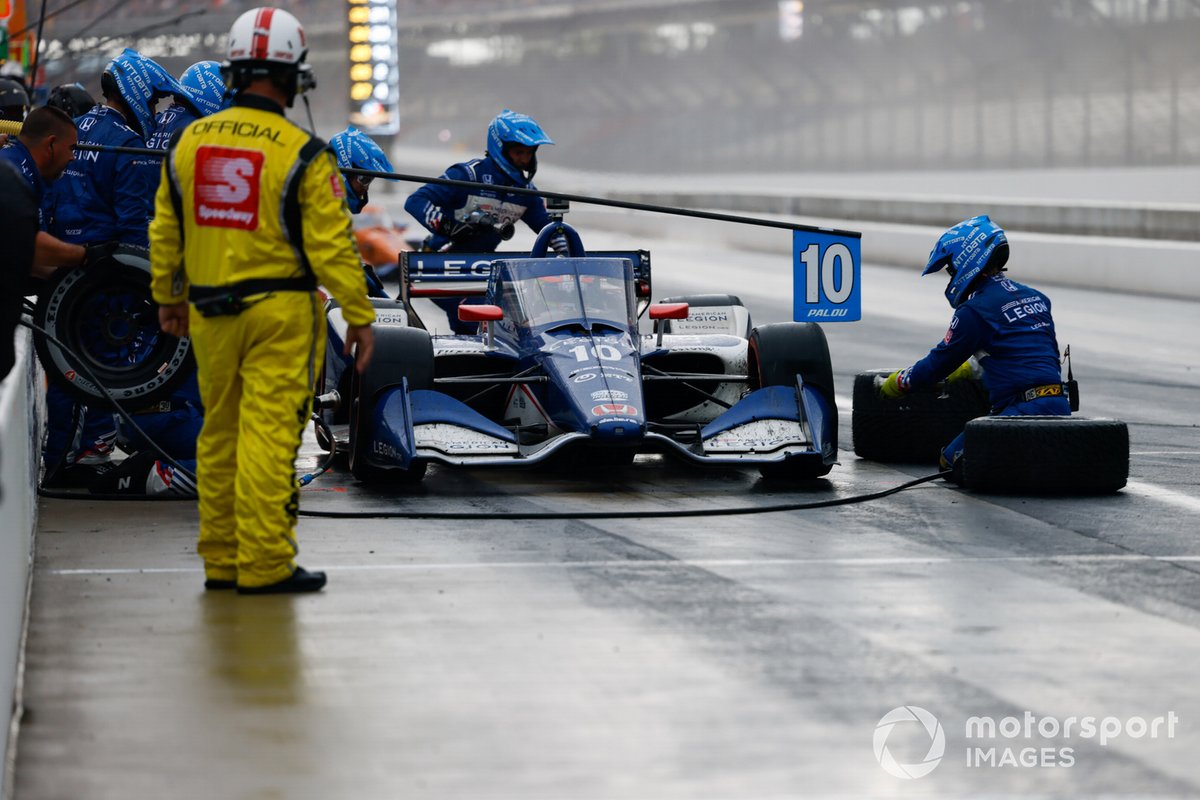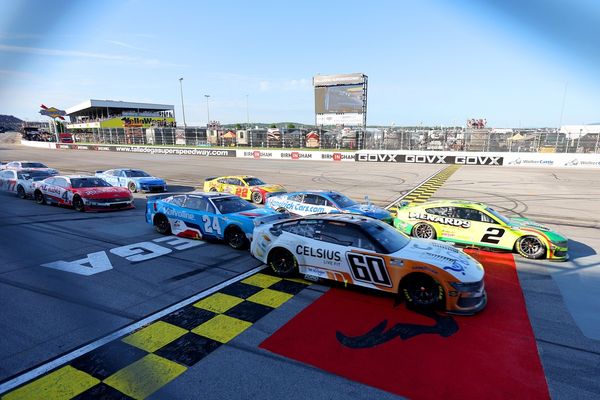
The 12th IndyCar race on Indianapolis Motor Speedway’s road course – seems an age ago now – started in drizzle, went dry, the drizzle returned, and then it became full-on wet. It made for an intriguing event, which involved 471 passes – 362 for position – and there were 10 lead changes among six drivers, one of whom was Tatiana Calderon and none of whom was the polesitter.
As the rain increased over the final 15 laps of what became a two-hour timed race, the visibility for drivers naturally deteriorated, and according to several of them, the aeroscreen exacerbated the issue. IndyCar introduced the screen from the start of the 2020 season but aside from Spring Training at Circuit of The Americas in February, a two-car test at Barber and a qualifying session at Mid-Ohio that same year, the screen had not been trialed in the wet, and certainly never with cars en masse. GP Indy race saw 27 starters, and all but one were still running in the final stint: that’s a lot of spray.
Conor Daly, who qualified a superb fourth, dropped down the field, then rose to finish fifth for Ed Carpenter Racing-Chevrolet, said he was struggling to see.
He told NBC, “I couldn’t see a single thing all the way down the front straight, all the way down the back straight.” Then he popped his head still further above the parapet when facing the specialist media, explaining: “It was like the water just stayed in the center of the screen. I don't know why, but even as you went faster, you would hope it would clear but it didn't…
“Obviously, this is very much a scientific test run. We have a lot of data to go through with the series, and I'm sure Jay Frye will look at it as well. He hates when I talk about the aeroscreen, but I'm just describing what I saw. That's all. It was challenging. Thankfully, we had a great spotter in Packy Wheeler, who was literally guiding me into Turn 1. I couldn't see the brake zone or the cars in front of me or the end of the pit wall, but I could look out the side of the aeroscreen, so I was looking right and left to go straight…”
He later added: “Even under yellow, I couldn't see the cars in front of me. I had to be guided into pit lane, and that's concerning.”
Rookie Christian Lundgaard, who finished ninth, also couldn’t see out at caution speeds, and crashed his Rahal Letterman Lanigan-Honda into the back of Callum Ilott’s Juncos Hollinger Racing-Chevrolet on the run to the flag. He said: “I couldn't see anything. I was pretty much complaining for the last 10 laps. It was just so low visibility.”
Winner Colton Herta’s view (no pun intended) was colored by the fact that he barely followed anyone at racing speed while the track was at its wettest, because he was out in front. Nonetheless, it’s worth registering his opinion that, “I think we would have been in the same situation without the aeroscreen there at the end, because it was really, really wet.
“The only down side I think was not having a tear-off when it dried up [following the damp opening few laps] because you get all the mud and dried raindrops on there. But once I had a tear-off [removed], it was fine. I think a lot of people were worried about the fogging because it can still be quite muggy when it's raining here, but it wasn't a problem for me. I was happy with it.”
Runner-up Simon Pagenaud sounded almost conflicted, stating that he “couldn't see anything, I couldn't drive, I was just surviving at the end,” but at the same time he was “thankful that IndyCar let us race in these conditions.” The 2016 champion has won races in the wet in both IndyCar and sportscars, so his enthusiasm for the conditions is understandable, and apparently overcomes the fact that while chasing Herta, he was having to gauge his braking point for Turn 1 via marks on the catch fencing.
So both he and third-place finisher Will Power were careful to not publicly criticize the aeroscreen.

“A wiper would have helped,” said Pagenaud. “Obviously I'm not an engineer. I don't know what we should do. But it's the first real test for the aeroscreen. It's only been positive. I'm not being negative at all… As we saw in Texas, it saved Callum [Ilott, whose aeroscreen was struck by the flying suspension wishbone of the crashing Jack Harvey]… So we'll find solutions and improve it and make sure that when we have rain races – hopefully we have more – then we don't have these issues.”
Power, meanwhile, admitted visibility was bad but didn’t suggest the aeroscreen was the issue. Instead, he said it was simply the corollary of 25-plus fast cars throwing a large amount of water into the air, and his only question was whether the track was too wet up at Turn 12.
“There's really nothing you can do about [visibility] with open-wheel cars,” said the Penske driver. “It's just going to be a lot of spray. Honestly, it was on the edge of whether we should have been running right at the end there. I was starting to get a bit of aquaplaning.”
In other words, he’d have understood if IndyCar had thrown the red flag. But he had not a word to say specifically against the aeroscreen. He understands that the positives of the device far outweigh the negatives.
Inevitably, some drivers wished not to be quoted on the topic, but privately described the same phenomenon that Daly had encountered, with water build-up in the center of the screen, while others were more fervent on the topic, saying that for future wet races, IndyCar should consider taking off the screen element while retaining the halo.
The case for the defense

The man behind the big push for the aeroscreen was Jay Frye, IndyCar president, and it’s only fair to give him the right of reply to the criticisms. And, full disclosure here on my part: as someone who’s advocated for cockpit head protection in open-wheel series ever since Justin Wilson’s death at Pocono in 2015, it’s very hard not to sound like a shill for the series on these matters.
Best, therefore, to largely let Frye talk. Outside of the drivers, no one is more personally involved in the aeroscreen problem, because he’s seen it protect IndyCar drivers in potentially extreme circumstances.
“The merits of the aeroscreen are indisputable,” he tells Motorsport.com. “You’ve seen things in the last couple of years where the outcome was exactly what we wanted. The Rinus VeeKay/Colton Herta collision at Iowa [2020], Ryan Hunter-Reay’s collision after [Josef] Newgarden’s spin at Barber last year, Ilott hitting Harvey’s flying debris at Texas this year… Everybody involved is fine. We’re very proud of that.”
His point may also cross a reader’s mind when viewing the onboard footage from Lundgaard as he drives through the debris from Ilott’s accident in the Indy 500.
Still, it’s important that a passive safety measure doesn’t create an active safety hazard. How does Frye – IndyCar – answer criticisms of the aeroscreen’s properties in the wet?
“Let’s go back and put this in context,” he responds. “When we first introduced this screen, and drivers were concerned about overheating in the cockpit, what did we do? We introduced the helmet hose, the air intakes, the scoop, the cool-suits and even moving the drink bottle. Then as we were going through that process, some drivers were coming in saying they were still hot so we would go research their issues and learned that the teams weren’t using all the tools we gave them. At that point, we think, ‘How can we help if we’re providing a variety of options and they’re not used? That’s not very helpful.’ In the case of the scoop – some drivers say it helps, some say it doesn’t. The good thing is that if we reach a certain ambient temperature, a certain heat index, we just mandate it, so it’s the same for everybody.
“We get to GP Indy, and we’ve never had anything like that in terms of the amount of rain since we had the screen. Despite the two tests in the wet, we’ve never been able to simulate 27 cars driven in anger on a wet track. Well, now I believe we’ve learned from that, because we did what we always do which is go out and check with all the teams. We’ve given them these tools. Heated screen: how many of them had it on? Tear-offs: how many did each car have on and how many did they tear off during the race? The anti-drip rail: was that on their cars? And the answers vary.”
Frye has doubts that the collection of water in the center of the screen, a phenomenon only experienced by some cars, is an aerodynamic issue caused by the central wicker or caused by the drip rail or the combination of both. His reasoning is that everyone was running maximum aero downforce – 1) because it was wet, and 2) because if it turned dry and stayed dry it would be hot in Indiana in May – so if everyone’s running the same aero package, there should be no variance in how the rain water behaves on the screen from car to car. Therefore, he is evaluating if tear-off installation could be a factor on some cars, perhaps allowing pockets of water to build up between the stacks.

“Again, we need to collate everyone’s data, so we know whether teams ran just the four-stack package of tear-offs or if they added to it, and how,” he says. “The problem is that some teams didn’t tear off their tear-offs! Well when you get a mixture of water, rubber, stone chips, oil, whatever, then obviously that is going to hurt visibility. That’s what the tear-offs are for! Honestly, the feedback we got was all over the place.”
In matters such as these – non-competitive matters – Frye says the team owners, managers and technical directors have no qualms about providing feedback and allowing it to be shared with other teams.
“Oh, yeah, no problem there,” he says. “If there was an issue where two or three teams found water got behind the tear-offs, and the others didn’t have that issue, sure we’d tell the ones who had issues, ‘Hey, you should do it this way.’ And all the teams are well aware of what we’ll share and what we won’t. The ones who got it right wouldn’t complain that we told the ones who got it wrong how to solve the problem because 1) it’s a mandatory piece and 2) it’s a safety issue.”
Inevitably, there is a period of adaptation to any new device and because IndyCar so rarely has to run in the rain, it may take a couple of seasons for drivers to gain enough experience of the combination of aeroscreen and wet weather to quit quibbling. The dearth of opportunities, historically, to run in the rain is also possibly key to them having forgotten what it’s like to hurtle into a ball of spray at 170mph, with or without a screen.
It’s easy to sit viewing this action from the outside and dismiss the drivers’ complaints with comments along the lines of, ‘Oh just get on with it, this is what you’re paid to do’. It’s quite another to be in the cockpit, flicking the wheel from side to side to catch the car as it loses traction, while simultaneously peering through spray to see the rain light of the car in front and scanning trackside clues for when to start braking, when to start turning in. But again one returns to the fact that not all the drivers gave a thumbs-down regarding what they could or couldn’t see.
“I was getting texts from drivers after the race saying they were fine,” says Frye. “They said it was intense, but it would have been intense with or without the aeroscreen.
“So do I think anything is wrong with the aeroscreen? No. Do I think we can learn things from that wet race, and make it even better? Absolutely. We’ll collect all the information from the teams, and we’ll find out if one team didn’t report problems and another one did, then why? What did one team do that the other one didn’t? Because maybe there isn’t a problem: like with the cooling devices, maybe they just need to use what they have.
“You know, we do take the attitude that if there’s one driver with an issue, that’s one too many. We don’t need a consensus or a big percentage. We’ll look into what their problem is.”
Whatever, Frye is as adamant that the problem will be solved as he is adamant that the screen will remain in place, come rain, wind or shine.
“We’ve seen the screen do too much good to even consider removing it,” he says. “I think Will [Power] said it best, when he and Scott did the test at Indy for the first time [in the fall of 2019]. By the end of just a half-day test, he said he’d feel naked without the aeroscreen: that’s how quickly the drivers adapt.
“It’s indisputable what the screen has done, and I tell you, I sleep better at night with this thing in place.”
And running just the halo piece instead of the halo-’n’-screen combo when it’s wet is not even a consideration.
“No,” says Frye firmly. “We tried to come up with a total cockpit protection solution, and that involves all of it. Can we make the cooling better? Absolutely. Can we work on the weight? Yes, and we are. But taking care of our drivers is the number one thing that we do. The aeroscreen is there because it’s the right thing to do.
“We did it for three reasons. Number one, by a long shot, was for safety. Number two is tied in, and that’s recruiting drivers from all over the world who might not have been so keen to race ovals if there was no screen there. And three, the teams could monetize it with advertising space.
“So when I hear it’s too hot in there? OK, we’ll fix it. There were some vision issues on some cars in the wet? Fine, we’ll take a look at that and see why it was OK for some and not others.
“But the screen is not going away.”








